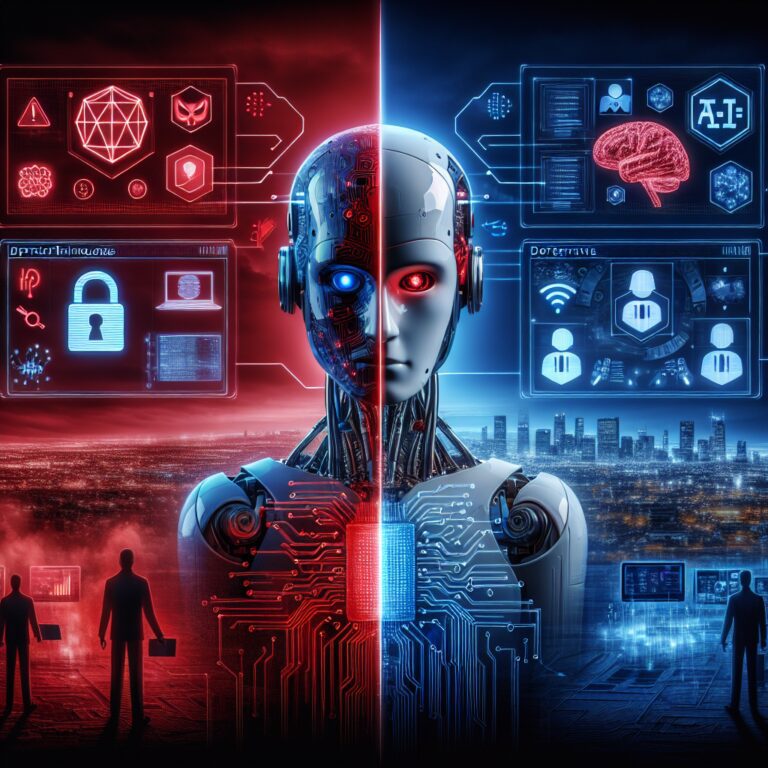# **AI Integration Enhances Cybersecurity Offense and Defense for Organizations**
In the constantly evolving digital landscape, organizations face an unprecedented surge in cyber threats. Hackers are becoming more sophisticated, and traditional security measures often fall short. Enter Artificial Intelligence (AI) – a disruptive force that enhances both the offensive and defensive aspects of cybersecurity. This integration is not just a trend; it’s a necessity for organizations aiming to stay ahead of threats.
Let’s explore how AI is transforming cybersecurity strategies with actionable insights, real-world applications, and a peek into the future. Ready to bolster your organization’s defense line? Read on!
## The Current Cybersecurity Landscape
Today’s cybersecurity landscape is a battleground. Organizations are under constant siege from a wide range of threats:
- Phishing Attacks: Sophisticated social engineering tactics are fooling even the most vigilant employees.
- Ransomware: Malicious software that encrypts data, holding it hostage until a ransom is paid.
- Advanced Persistent Threats (APTs): Long-term, targeted attacks by well-funded attackers, often nation-states or organized crime groups.
These threats underscore the need for innovative solutions that go beyond conventional cybersecurity measures. This is where AI comes in.
## How AI Reinforces Cyber Offense
AI doesn’t just play defense; it’s also revolutionizing the offensive strategies of cybersecurity. Here’s how:
### AI-Driven Threat Detection
Machine learning algorithms have the capability to identify new patterns and anomalies that traditional systems may overlook. By continuously learning and evolving, AI can predict and neutralize threats before they manifest.
### Proactive Threat Hunting
AI tools can automate threat hunting processes, sifting through massive amounts of data to identify suspicious activities. This proactive approach allows cybersecurity teams to act before threats become a full-blown crisis.
### Predictive Analysis
Using historical data, AI can predict potential attack vectors and vulnerabilities within an organization’s network. This predictive capability enables security teams to bolster defenses where they are most needed.
## Strengthening Cyber Defense with AI
On the defensive front, AI is an invaluable ally. Here are some key applications:
### Real-Time Anomaly Detection
Traditional security systems often rely on predefined rules, which can be bypassed by savvy attackers. AI, on the other hand, uses machine learning to recognize deviations from normal behavior in real-time. This allows for immediate response to potential threats.
### Enhanced Network Security Protocols
AI can optimize network security protocols by constantly analyzing traffic patterns and detecting irregularities. This leads to more robust and adaptive security measures that evolve with the threat landscape.
### Data Protection Strategies
AI plays a vital role in protecting sensitive data. It can detect unauthorized access attempts and automatically trigger alerts or enact protective measures to secure data integrity.
## Real-World Applications of AI in Cybersecurity
AI is already making significant impacts in various sectors. Here are some notable examples:
### Financial Services
Financial institutions are leveraging AI to detect fraudulent activities. AI algorithms analyze transaction patterns and highlight suspicious transactions in real-time, minimizing financial loss and protecting customer assets.
### Healthcare
The healthcare sector uses AI to protect patient data and ensure compliance with regulations like HIPAA. AI systems continuously monitor access to sensitive information and flag any abnormal or unauthorized access attempts.
### Government Agencies
Governments employ AI to protect national infrastructure. AI systems monitor critical network activities, identify potential cyber threats, and coordinate responses to cyber incidents.
## Challenges of Integrating AI in Cybersecurity
While AI offers numerous benefits, its integration is not without challenges:
### Data Privacy Concerns
AI needs vast amounts of data to function effectively. This raises concerns about data privacy and the potential for misuse.
### High Implementation Costs
Setting up AI-driven cybersecurity infrastructures can be costly. Small and medium-sized enterprises might find it challenging to allocate resources for such implementations.
### Complexity and Skill Gaps
AI systems are complex and require skilled professionals to manage them. The current skill gap in the cybersecurity workforce can hinder the effective deployment of AI solutions.
## Future Implications of AI in Cybersecurity
The future of AI in cybersecurity looks promising. Here’s what we can expect:
### Autonomous Cyber Defense Systems
As AI continues to evolve, we could see fully autonomous cyber defense systems that can detect, analyze, and respond to threats without human intervention.
### Improved Threat Intelligence Sharing
AI can enhance threat intelligence sharing among organizations, creating a more unified front against cyber threats. This collaboration could significantly improve the overall security posture.
### Increased Regulation and Ethical AI
With AI becoming more ingrained in cybersecurity, we can anticipate more stringent regulations governing its use. Ethical AI usage will become a focal point, ensuring that AI systems are used responsibly.
## Conclusion
In a world where cyber threats are becoming increasingly complex and pervasive, integrating AI into cybersecurity strategies is no longer optional – it’s imperative. AI enhances both the offensive and defensive capabilities of organizations, providing them with an edge in the never-ending battle against cyber criminals.
Key Takeaways:
- AI-driven threat detection and proactive threat hunting make cyber offense more effective.
- Real-time anomaly detection and enhanced network security protocols strengthen cyber defense.
- AI’s integration faces challenges like data privacy concerns, high implementation costs, and skill gaps.
- The future holds promise for autonomous defense systems, improved threat intelligence sharing, and ethical AI use.
By staying informed and embracing AI, your organization can protect itself against existing and emerging cyber threats. Be proactive, leverage advanced technologies, and fortify your defenses – the future of cybersecurity is here.
**References:**
1. DataQuest. (2023). *AI Integration Enhances Cybersecurity Offense and Defense for Organizations*. Retrieved from [DataQuest](https://www.dqindia.com/interview/integrating-ai-in-offense-and-defense-helps-organizations-protect-themselves-7063165).
2. IBM Security. (2022). *The Role of AI in Cybersecurity*. Retrieved from [IBM](https://www.ibm.com/security/artificial-intelligence).
3. PwC. (2023). *AI in Cybersecurity: Current Trends and Future Prospects*. Retrieved from [PwC](https://www.pwc.com/gx/en/issues/cybersecurity/data-insights/ai-cybersecurity.html).
—
By leveraging the power of AI, organizations can stand resilient against the ever-evolving cyber threats. Now more than ever, it’s time to embrace technology’s prowess and safeguard what matters the most.




